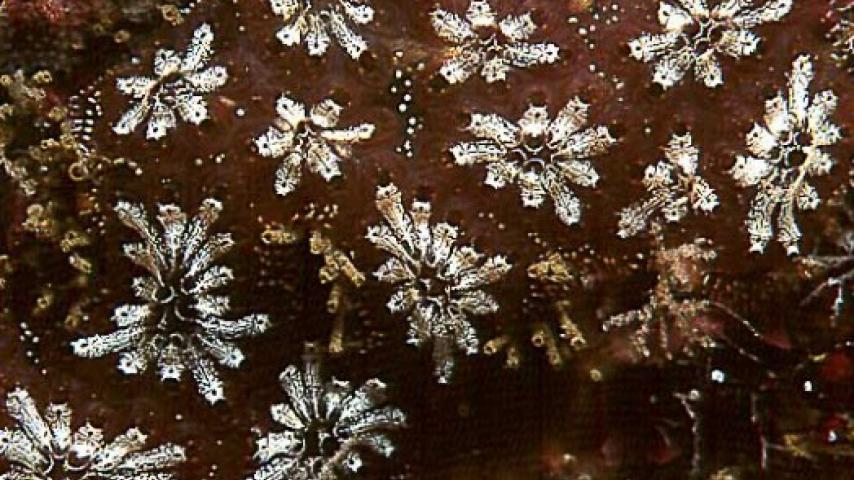Star Tunicate (Botryllus schlosseri)
Tunicates, also called ascidians, are the “sea squirts” we find in marine environments.

KINGDOM Animalia - PHYLUM Chordata - CLASS Ascidiacea - ORDER Stolidobranchia - FAMILY Styelidae
When you come near one that has been exposed by the falling tide, it may squirt out a jet of water. Some clams do this as they pull in their siphons, and for the same reason. When the tide recedes, the animals keep sea water bathing their respiratory organs to allow normal respiration. Better to lose water than to get eaten, though!
Tunicates are members of the phylum Chordata, along with some other odd-looking marine animals and the familiar vertebrates—fish, amphibians, reptiles, birds, and mammals. They are classified along with us because, in their larval stage, their body is supported by a notochord, a dorsal elastic rod that provides structural and locomotory support in the earlier-evolved groups and is replaced by a vertebral column in more advanced groups.
Tunicates are amazing animals. Anyone would call them invertebrates, and they are, though they are more closely related to us than are squids and crabs and many other fast-moving free-living marine animals. Tunicates are fixed in place, sessile filter-feeding animals that need water currents flowing around them to bring them food, carry away their wastes, and spread their reproductive efforts.
Some tunicates are compound; that is, they are colonies of many individuals that have budded off from a parent individual, the original colonizer of a substrate. They form gelatinous films, even over mussel shells, worm tubes, and solitary tunicates. The individuals are called zooids, and the zooids of this species are arranged in star-shaped, oval, or circular clusters. Each zooid pulls in water and filters it, and the water enters a common chamber from which it exits the colony through a central pore.
This species is especially interesting in being polymorphic, occurring in a variety of different color morphs. The common colors of colonies are orange and purplish, the same colors as the two morphs of the Ochre (and purple) Sea Star. Is this a coincidence or of some significance?
Tunicates produce eggs within the colony during spring, and these grow into tadpole larvae that are eventually released into the water. These larvae are the closest things morphologically to the higher chordates. Within a day or so, they find a substrate and anchor by their head end, produce a zooid, and begin to bud off a colony. These colonies develop through the summer and reproduce in fall, producing winter colonies that live until the next spring, when they reproduce.
Probably originally native to the European coast, the species was brought into the American side of the Atlantic, perhaps on material clinging to ships. By the 1970s, it was widely introduced all along the Pacific coast of North America, and it is considered an undesirable invasive species now, as it is able to cover native species during its rapid growth.
This invasion may have been fortuitous for human health. Colonies of this species, when they grow together, either fuse or reject one another completely. As there are elements of this similar to acceptance or rejection of transplanted cells and tissues, researchers in several laboratories are studying Botryllus. The proteins that are involved in this are similar enough to those in humans that insights in immunology are being gained, for example in AIDs research.